Vietnamese Steamed Banana Cake (Banh Chuoi Hap)
Vietnamese Steamed Banana Cake (Banh Chuoi Hap) is delicious with a wonderful fragrance and sweetness from ripe bananas. The soft-chewy texture makes this cake seriously addictive.
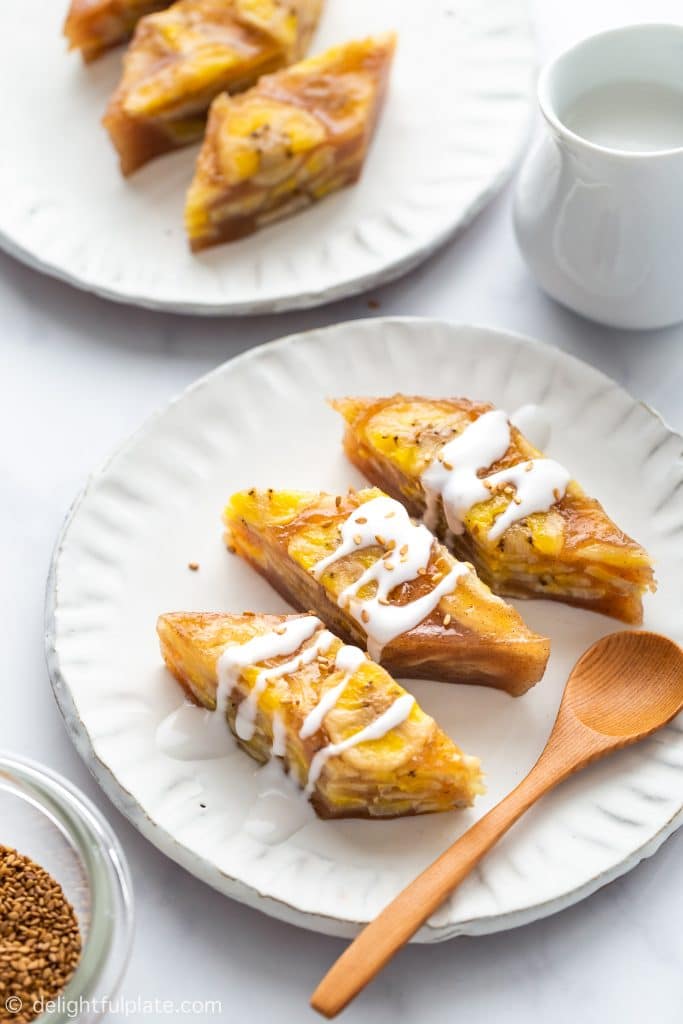
What is Vietnamese Steamed Banana Cake
Vietnamese Steamed Banana Cake (Banh Chuoi Hap) is made by steaming a batter of tapioca flour, rice flour and ripe bananas. It is then served with a rich coconut sauce and toasted sesame seeds.
Each bite is full of fragrance and sweetness of bananas which pair well with the creamy coconut sauce and nutty sesame seeds. The cake is dairy-free, gluten-free and vegan.
Compared to Western cuisines, most desserts in Vietnamese cuisine are made on the stovetop such as sweet soups (chè) or steamed cakes. The lack of baked desserts in Vietnamese cuisine isn’t really a surprise since even today, not many home kitchens in Vietnam have an oven.
This delightful steamed cake is just one of many delicious Southern desserts that use bananas and coconuts which are abundant in the South of Vietnam. Other Vietnamese desserts with this flavor combination is this Che Chuoi (Banana Tapioca Pudding) and Grilled Banana Sticky Rice (Chuoi Nep Nuong).
Ingredients
To make Vietnamese Steamed Banana Cake (Banh Chuoi Hap), you will need ripe bananas (pisang awak variety for best result), tapioca starch, rice flour, and sugar. Use just ripe bananas and avoid using overripe bananas which can get too mushy after steaming.
The combination of tapioca starch (also called tapioca flour) and rice flour creates an addictive soft-chewy texture for the cake. Both types of flour are gluten-free and you can find them at Asian grocery stores. Please make sure you select Vietnamese or Thai brands such as this Thai rice flour and tapioca starch. The flour should be very fine and lightweight, kinda like cornstarch.

I often see that people add yellow food coloring to achieve a yellow color for the cake. However, since I use light brown sugar, the banana cake already has a nice golden brown color so there’s no need to use food coloring.
Besides, I also add cinnamon powder to enhance the aroma and add a warm note to the cake. This is my own idea which turns out wonderful (and I’m actually quite proud of it 🙂 ). If you have tried my spiced chocolate banana bread, you probably know how much I love the combination of banana and cinnamon.
For the coconut sauce, you will need canned coconut milk, cornstarch and sugar. My current favorite brand for coconut milk is Aroy-D.
Troubleshooting
If you scroll to the Comments section, you will see some people having issues with this recipe. I honestly made this multiple times before sharing on the blog and each time someone commented with issues, I made it again. I just made it again on 5/19/2020 with a combination of regular bananas and baby bananas and everything was still steamed into a cake.
So I really don’t know why it didn’t work for some people since I didn’t have their information about what brands of flour, types of bananas and other kitchen details. Here are a few things I want to emphasize:
- Please make sure you use rice flour and tapioca flour from Viet or Thai brands. I often use Vinh Thuan brands. Some comments say the amount of water is not enough for the batter, but I never have that issue. I’m guessing they are not using the correct types of flour.
- Use pisang awak bananas for best results. I can still steam the cake with regular cavendish bananas but the bananas will be much softer with less taste. Besides, cavendish bananas will get brown fast and won’t look as pretty. If you really want to try the recipe with regular bananas, don’t slice them too thin (slice them thicker than the pisang awak banana slices in my photos). Otherwise, I suspect they will get mushy and release a lot of moisture into the batter mixture. Overripe cavendish bananas will absolutely not work for this recipe.
I’m always happy to help with troubleshooting, but in order to do so, I need as much detailed information as possible. I do make my recipes multiple times before sharing them.
How to Make Vietnamese Steamed Banana Cake
Not only does this cake require few ingredients, it is quick and easy to make as well. You will need to set up a steamer and find a mold (I use a loaf pan) which will fit inside the steamer.
The first step is to slice the bananas thinly and marinate them with light brown sugar for 20-30 minutes. After that, gently fold the banana slices into the batter.

Steam for 25-30 minutes until the cake is cooked through. The batter will turn translucent and the edges will start to pull away from the mold slightly. If you insert a toothpick, there should be no wet batter on the toothpick.
While steaming the cake, you can quickly prepare the coconut sauce. I like to serve both the cake and the sauce warm. You can store both of them in the refrigerator and then reheat both in your microwave when you want to eat it.
Detailed measurements and step-by-step instructions are in the recipe card below. I hope you will like this steamed Vietnamese banana cake as much as I do.
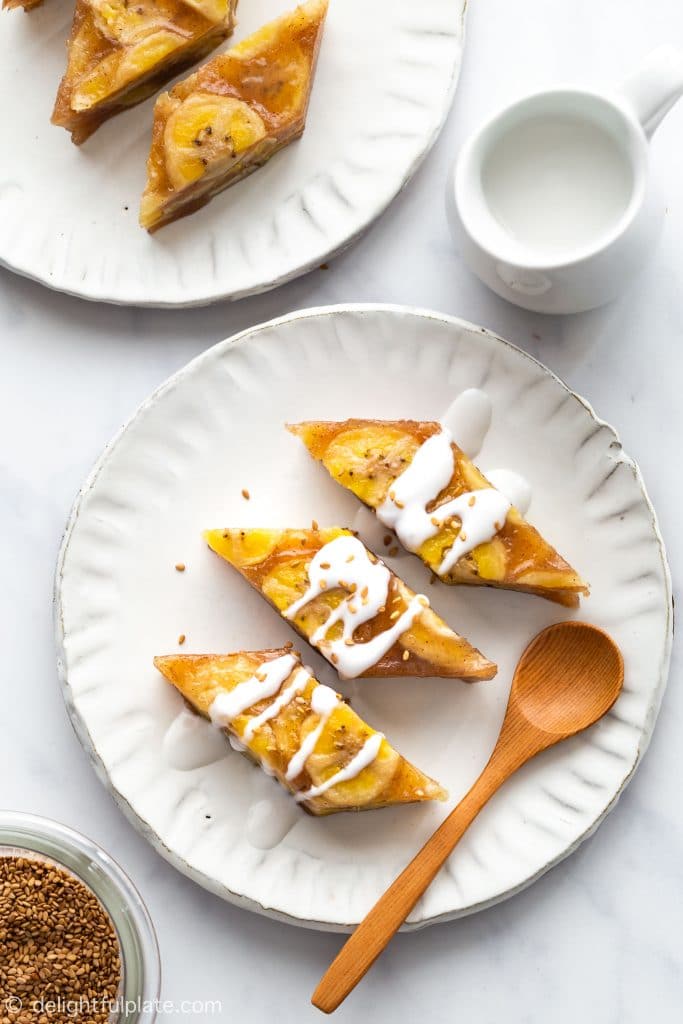
I’d love to hear what you think about this dish, so please feel free to leave a comment. New recipes are added every week so let’s connect on Facebook, Pinterest and Instagram for the latest updates. You can find my collection of Vietnamese recipes here.
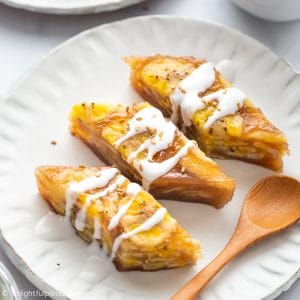
Vietnamese Steamed Banana Cake (Banh Chuoi Hap)
Ingredients
For the Banana Cake
- 5-6 peeled pisang awak bananas, about 10.5 oz or 300 grams
- 3 tablespoons packed light brown sugar
- 2.5 oz tapioca starch (also called tapioca flour)
- 1.5 oz rice flour
- 1/8 teaspoon salt
- 1/2 teaspoon cinnamon powder
- 1/4 cup plus 3 tablespoons water
To serve
- 1 1/4 cup canned coconut milk
- 1/4 cup plus 1 tablespoon water, divided
- 1/8 teaspoon salt
- 2 teaspoons sugar
- 1 tablespoon cornstarch
- toasted sesame seeds
Instructions
Making the Steamed Banana Cake
- Slice bananas thinly and add the banana slices to a mixing bowl. Add brown sugar and gently toss to coat the banana slices with sugar. Set aside to marinate for 10-20 minutes.
- In another mixing bowl, combine tapioca starch, rice flour, salt and cinnamon powder. Then add 1/4 cup water and 3 tablespoons of water, mix well to create a smooth batter.
- Reserve about 12-15 banana slices to decorate the top of the cake later, add the remaining banana slices to the batter. Gently fold the banana slices into the batter.
- Pour the batter into a mold or pan which will fit inside your steamer (I use a loaf pan). Ideally, use a 4''x8'' loaf pan so that the cake will have a height of slightly over 1 inch. Place the reserved banana slices on top for decoration.
- Set up a steamer and wrap a clean towel around the lid to prevent water condensation to drop on the cake (or wipe the lid clean every 10 minutes). Steam the cake over medium to medium-high heat until cooked through (about 25 minutes). The batter will turn translucent and the edges will start to pull away from the mold slightly. If you insert a toothpick, there should be no wet batter on the toothpick.
- Remove the mold/pan from the steamer and let it cool down enough to handle. Take the cake out of the mold/pan. Cut into slices and serve warm with coconut sauce and toasted sesame seeds.
Making the Coconut Sauce
- While steaming the cake, place a small saucepan over medium-low heat. Add coconut milk and 1/4 cup of water and heat gently. Stir in salt and sugar.
- Combine cornstarch and 1 tablespoon of water in a small bowl. Once you see a lot of steam from the coconut milk mixture and small bubbles around the edge, slowly add the cornstarch slurry while whisking to thicken the coconut sauce. Do not let the sauce boil. Add just enough cornstarch slurry to achieve desired thickness. Transfer the sauce to a clean bowl.


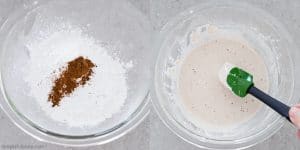
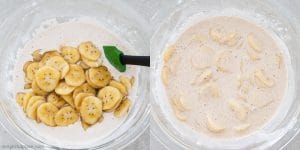
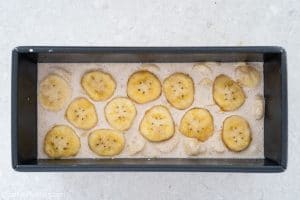
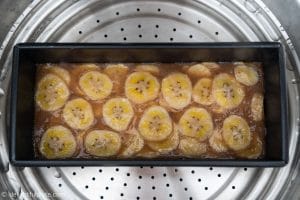
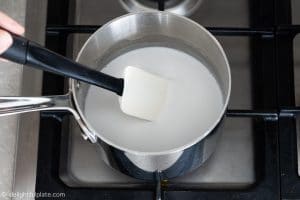
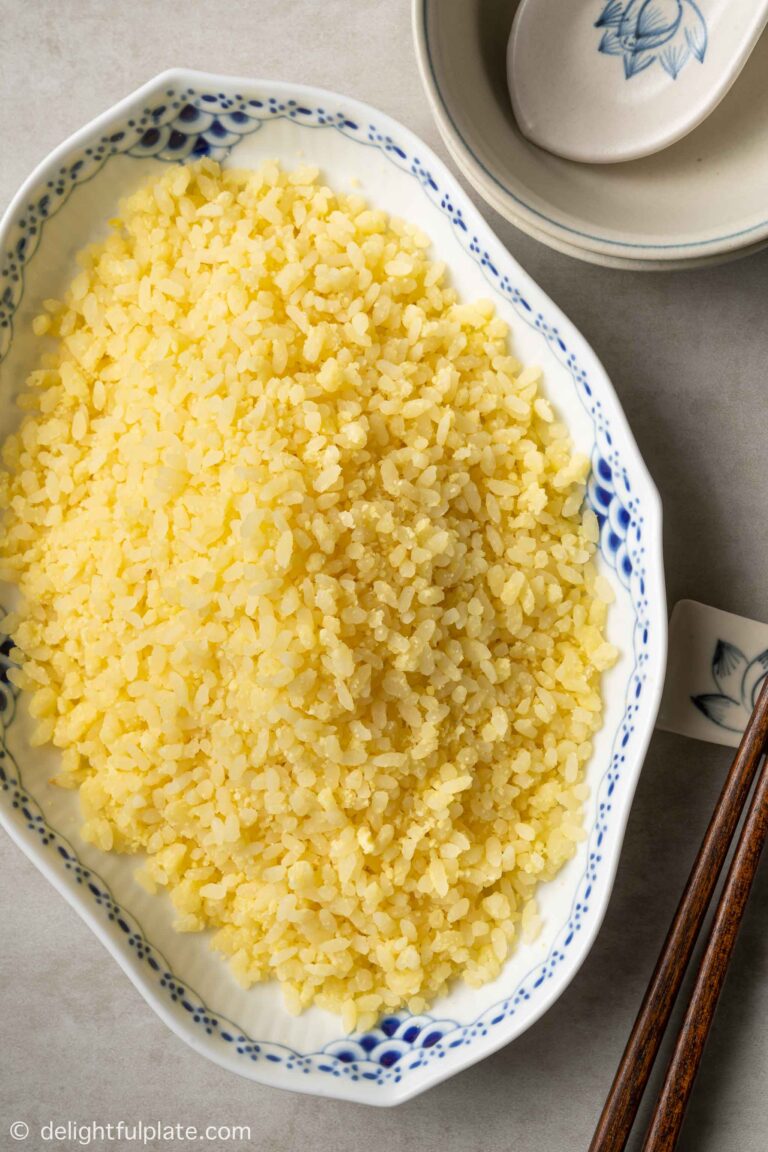


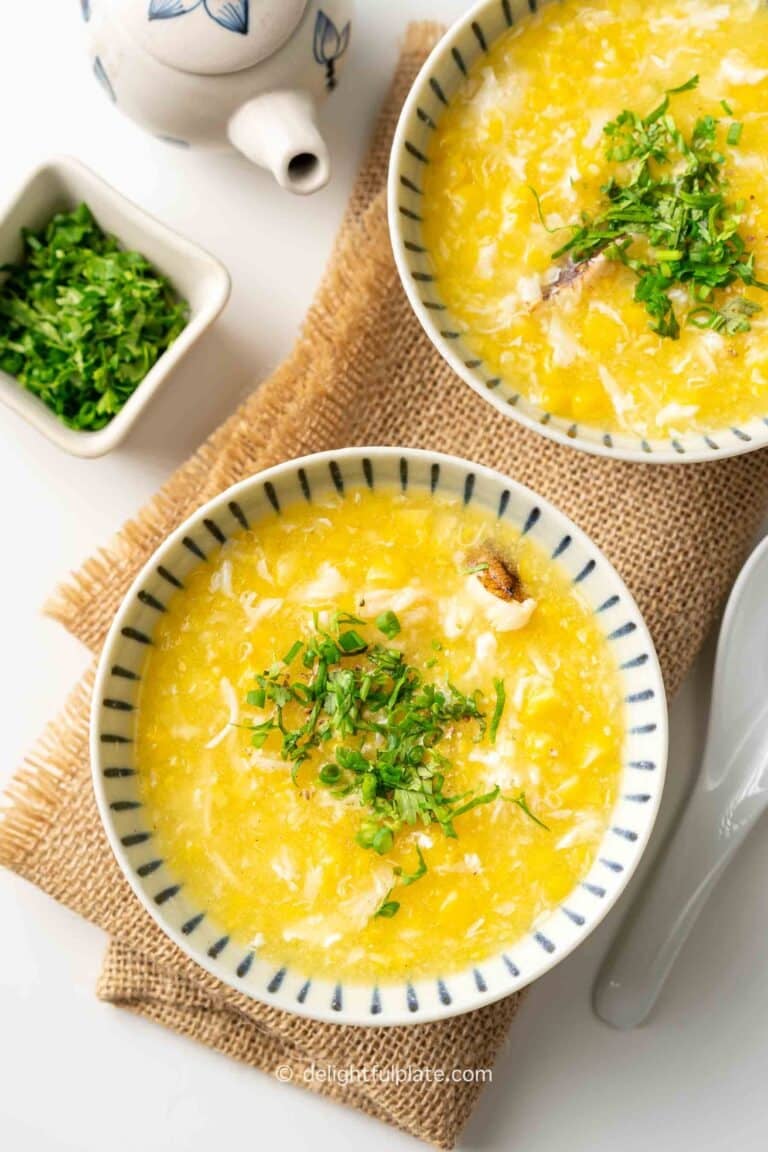


Do you wait for the water to boil then put the cake pan into the steamer?
Yes, we need the water to boil before putting the pan into the steamer.
I made the recipe twice this week and it has turned out great both times! I love the addition of cinnamon to the cake. I am using the gram weights for measuring the bananas, tapioca and rice flours. Not sure if that would make a difference for anyone who is having difficulty. I also made sure the brown sugar was well incorporated with the bananas, added a pinch of salt, then covered them and set them aside for 30 minutes. There was a bit of liquid in the bottom when I added the flours. Again, not sure that will help. I steamed mine in small ramekins, and reduced the steaming time to 10 minutes. Thank you for this recipe, I’m having such fun with it!
Yeah… this was a fail. I was so excited for this recipe because the brown sugar bananas were DIVINE. But I ran into the same problems as everyone else where I had to add 4x as much water to get something even resembling a batter, and I steamed my loaf for over an hour and it was still liquid. I even put it in the oven afterwards for an additional 20 minutes and it just wasn’t cooking. Burnt on top, and not even “chewy” inside, just liquid. I don’t know what to say… I measured the flours using a scale and I used a korean rice flour and homemade tapioca flour. I think if choosing a specific brand of flour is necessary for successful results, then the brand of flour used should be put in the ingredients list. Pretty disappointing overall.
I don’t have a steamer to accommodate my loaf pan
Can I bake in oven
Thank you
Shirley Lim
Hi Shirley,
I haven’t made it in the oven so I can’t say with confidence that it will work. You can try baking it with a water bath (placing your loaf pan in a larger baking pan and fill the baking pan with hot water halfway) at low temperature, like 300-325°F. Since some other desserts like caramel flan can either be steamed or baked, I guess there’s a chance this may work too but I’m not 100% sure :). Another option is maybe making individual portions in ramekins so that you can fit them in your steamer? If you decide to bake it, I look forward to hearing how it turns out. Thanks!
Is it possible some are using glutinous rice flour instead of ordinary/plain rice flour? They are different.
Hi Patricia,
Thank you for leaving a comment! That is possible. Glutinous rice flour and regular rice flour have different textures. I wish I knew exactly what some used.
Hi, thank you very much for posting this recipe and for your professionalism. I tried this recipe and measure everything and it turned out great. I have to admit it took a little longer then expected (40-45 mins) but it was only because of my own skepticism. I think it was done around 25-30 mins but I didn’t want to take the chance. For those who hated this recipe, try something else. There’s no need to be mean. This dessert is not meant to be overly sweet and the texture is supposed to be chewy. My (Vietnamese) husband said it taste like the dessert you would buy at a Vietnamese store and I take that as a compliment 🙂
Hi Cat,
Thank you so much for the feedback! I’m glad that it turned out fine for you. Yes, the texture is supposed to be chewy (there’s sometimes food that we enjoy in Vietnam almost purely for texture :D). I also take your husband’s comment as a compliment. Thanks again for taking the time to come back and let me know. I greatly appreciate it.
There is something seriously wrong with this recipe. Like comment above, it took forever to steam and I gave up. It produces an unpleasant rubbery gelatinous mess. I read through the recipe again and I’d followed each step precisely.
Hi Alan,
I’m sorry that it didn’t turn out well. I will test it again to find out what can cause the issues. I would appreciate it if you can let me know the brands of flour and the types of bananas you use. That will help me figure out the issues. Thank you.
Hi again Alan,
I just made the cake again today and it took me around 25 minutes to steam as written in the instructions. I’m happy to troubleshoot, but with the limited information you provided, it is hard for me to figure out why it didn’t turn out for you. It could be because of the brands of flour, types of bananas you used or it could just be due to wrong expectations. Thank you for taking the time to write the feedback. I added a troubleshooting section to the post to explain what may go wrong.
Something is amiss from your recipe.
Somewhere in your recipe, you mentioned that regular bananas can be used however they would become brown too fast…
This is a steamed dish – how can anything become brown? Thank you.
Hi Ann,
What I meant was it would turn brown as if because of oxidation. I didn’t mean it would turn browned as if it was baked. Sorry for any confusion.
Anyway, please note for this recipe, regular banana is not the best choice since it gets soft very quickly.
Hi Sophie,
It really seems that is something wrong in the quantitites. The batter comes really dry, I had to triple the water. It was not bad but maybe too chewy.
Thanks
Aura
Hi Aura,
Thank you for the feedback! I just tested the batter again by mixing 3 batches, not just one, and all of them came out fine. I tested both the grams measurements and oz measurements:
– 42 grams rice flour (1.5 oz)
– 70 grams tapioca starch (a bit under 2.5 oz)
– 105 ml water (1/4 cup plus 3 tablespoons)
If you don’t mind, could you please provide a bit more information so that I can figure out why it came out dry for you? What brand of rice flour and tapioca flour did you use? I always use Vietnamese and Thai brands and the flour is very fine and lightweight. Some rice flour from American brands (such as Bob’s Red Mill) can be grainy and heavy, which may not work.
How did you measure the flour? Did you weigh them by grams or oz? Or did you use the measuring cups? I would say measuring these types of flour with cups can be highly inaccurate, depending on how the flour is added to the measuring cups (for example, spooning into vs. scooping out).
Another possibility is there might be something wrong with my scale…
Any additional information you can provide is greatly appreciated. Thank you so much!
Sophie
Dear Sophie,
The topioca flower was maybe a bit grainy, I will try with a more fine one. thanks also for the specifications in grams and ml. Maybe is more precise .
thanks
There is also the possibility that people are using cassava flour and not tapioca flour. Though they are from the same part of the plant cassava is the equivalent of whole wheat and tapioca is the equivalent of AP or cake flour. The textures are different enough to make a difference in the finished product.
Hi Katie,
Thank you for suggesting the differences between cassava flour and tapioca flour. It really didn’t come to my mind at all that some may think they are the same thing. Thank you for pointing that out and I truly appreciate both comments you took the time to leave on this recipe.
This by far was the worse thing I have ever tried. First recipe amount of water did not make a batter it made bricks. It took an hour to cook let’s say after an hour of steaming I gave up The sauce had no coconut flavor just warm sugar milk. There is nothing positive I can say. We did get a good laugh then I ran to the store for a dessert I could take to a dinner party. You should be ashamed
Hi Willia,
Thank you for the feedback and I’m sorry to hear that it didn’t came out right for you. I just mixed 3 batches of the batter to test again and all of them came out fine for me. None of them was dry.
Could you please provide a bit more information so that I can look into it? What brand of rice flour and tapioca flour did you use? I always use Vietnamese and Thai brands and the flour is very fine and lightweight. Some rice flour from American brands (such as Bob’s Red Mill) can be grainy and heavy, which may not work.
How did you measure the flour? Did you weigh them by grams or oz? Or did you use the measuring cups? I would say measuring these types of flour with cups can be highly inaccurate, depending on how the flour is added to the measuring cups (for example, spooning into vs. scooping out). I strongly recommend using a scale to weigh the flour by either gram or oz.
What brand of coconut milk did you use? It seems a bit strange that the sauce was like warm sugar milk. Coconut milk itself contains no sugar and my recipe suggests only 2 teaspoons of sugar for 1.5 cups of liquid, which results in a very lightly sweet coconut sauce.
I always appreciate constructive comments and though I try my best to be careful when testing recipes, I’m not free of human errors. And I understand the frustration when things don’t come out right when trying online recipes. However, stating that the author should be ashamed without fully understanding what went wrong seems rather rude and unnecessary.
Thanks,
Sophie
I agree. Just because the recipe didn’t turn out for you doesn’t mean there’s anything wrong with the recipe. Weather and other factors can affect the finished product. As for the coconut sauce not all canned coconut milk is created equal. Some are downright awful. Arroy-d is the best and a good runner up that you can find at most grocery stores is Thai Kitchen. Most others have little coconut taste and weird texture. Just because it didn’t work for you doesn’t give you the right to harass the author. No one is forcing you to make or eat this recipe.